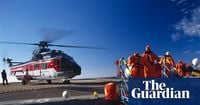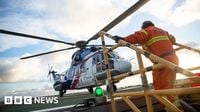Thousands of oil and gas workers across the United Kingdom are facing a stark ultimatum: lose weight or risk losing their jobs. By November 1, 2026, a new industry-wide guideline will require all offshore energy workers to weigh less than 124 kilograms (19.5 stone) while clothed if they wish to continue working offshore. The rule, announced by industry body Offshore Energies UK (OEUK), is designed to ensure that all personnel can be safely winched from oil and gas platforms by rescue helicopters in the event of an emergency.
The move, detailed in multiple reports including those from BBC, The Independent, and The Telegraph, comes after a comprehensive two-and-a-half-year safety review. The review, prompted by concerns from the Maritime and Coastguard Agency (MCA), found that current rescue winch systems are unable to safely lift individuals exceeding this weight threshold. The MCA had specifically warned that rescue winches—critical during offshore emergencies—cannot safely lift heavier people, necessitating a hard limit on worker weight for safety reasons.
Graham Skinner, OEUK’s health and safety manager, explained the rationale behind the policy in an interview with BBC Radio Scotland’s Good Morning Scotland programme. “We’ve really discovered a weight limit is the only solution available to us,” Skinner said. “We will be working really hard over the next 12 months to ensure affected workers can lose weight.” He acknowledged that about 2,500 offshore employees currently exceed the 124kg limit, with another 2,500 falling below the threshold but possibly needing weight management support. This brings the total number of potentially affected workers to 5,000 across the sector.
The technical details behind the limit are precise. The maximum Coastguard rescue helicopter winch load is 249kg (39 stone), which must account for not only the worker being rescued but also the average 90.3kg (14 stone) rescue worker, a 29kg (4.5 stone) stretcher, and 5kg (0.8 stone) of rescue kit. This leaves 124.7kg as the maximum safe clothed weight for an offshore worker. Exceeding this limit could mean a worker is unable to receive the necessary medical certification, effectively barring them from boarding a helicopter to reach or leave offshore installations.
“At that point an offshore worker who weighs over 124kg will not get their medical and that will preclude them from getting on a helicopter,” Skinner told The Independent. He emphasized that the industry’s goal is to avoid job losses, but conceded, “That would be the absolute worst-case scenario. Employers will have a duty to support their workers through this and try to find reasonable solutions, but in the very worst cases that would be the case for some people.”
For some, the policy is already having a personal impact. Phil Perry, a 42-year-old offshore worker from Aberdeen, shared his experience with BBC Scotland News. Perry, who once weighed 129kg (20 stone), has managed to reduce his weight to 118kg (18.5 stone) and aims to reach 110kg (17 stone) before the policy takes effect. “The fear of losing my job was an added motivation to keep my weight down,” Perry said. “You’ve kind of got to understand that back in the 70s and 80s the average person was about 70-odd kilos, it’s obviously going in an upward trend. I think you maybe have to do something about that, because you don’t want to be the one stranded there because you’re too heavy to be lifted out.”
Perry noted that while healthy living is possible offshore—with gyms, walking routes on the helideck, and healthy food options—temptations like crisps and sweets remain. “Everybody can lose weight, it’s keeping it off that’s the hard thing. I was one of these people that did these kind of crazy diets, but you can’t keep it off,” he admitted. Perry’s story underscores the broader challenge: weight management is not just about short-term fixes, but about sustainable lifestyle changes.
The new policy has sparked concern and debate among workers and unions. John Boland, regional officer at the Unite union, voiced worries about naturally larger but fit individuals who might exceed the weight limit. “The biggest concerns we have had are from individuals that are naturally larger built and in some cases are extremely fit but are above that actual weight limit. Those are discussions we need to have, how we can support those individuals as well,” Boland told the BBC. He stressed the importance of employer support to prevent job losses and accommodate the diversity of body types within the workforce.
Andy Prendergast, national secretary at the GMB union, was more critical, telling The Telegraph, “The idea that workers could be sacked for the size of their bodies is completely absurd. OEUK really need to withdraw this offensive proposal immediately. Considering the workers spend weeks at a time on their premises, the oil companies need to recognise their own role in this and actively help employees manage their health, not threaten them with destitution.”
OEUK, for its part, insists that employers have a duty to support affected workers and that comprehensive weight management plans are being put in place. Skinner highlighted community and employer initiatives already underway, including circuit training and gym sessions organized by offshore workers themselves. “It’s a great opportunity for the community to come together,” he remarked, expressing confidence that the vast majority of workers will be able to meet the new requirements with the right support.
The introduction of the weight limit is not the first time the offshore industry has adapted its safety protocols in response to changing worker demographics. Previous measures included upgrading lifeboats and categorizing helicopter passengers by shoulder width to ensure safe evacuation. The average weight of offshore workers has risen by nearly 10kg since 2008, reflecting broader trends in the UK population. According to NHS data cited by The Telegraph, the average UK male weighs about 86kg (13.5 stone), while the average woman weighs about 73kg (11.5 stone).
As the November 2026 deadline approaches, the industry faces a delicate balancing act: maintaining rigorous safety standards while respecting the rights and well-being of its workforce. The coming months will test the ability of employers, unions, and individual workers to collaborate on a solution that safeguards both jobs and lives in one of the UK’s most challenging working environments.
With the clock ticking, the message is clear—change is coming, and the stakes could not be higher for thousands of offshore workers and their families.





